Profiling vaccine hesitancy in nursing to tailor public healthcare policies: A cross-sectional international study
Abstract
Introduction
Vaccine hesitancy is a complex issue of global concern. As nurses play a vital role in delivering patient care and shaping public opinions on vaccines, interventions to address vaccine hesitancy in nursing are imperative. As such, identifying profiles of characteristics and attitudes contributing to hesitancy may help identify specific areas of focus to target tailored global vaccination uptake campaigns. The purpose of this study was to profile the characteristics and attitudes contributing to hesitancy toward COVID-19 and Influenza vaccines in the nursing community.
Design
This multisite, cross-sectional study recruited 1967 registered nurses and 1230 nursing students from the United Kingdom, Finland, and Italy between March and September 2023.
Methods
Data collection involved an online survey adopting the Vaccination Attitudes Examination (VAX) Scale, the Bergen Social Media Addiction Scale, and questions pertaining to sociodemographic and occupational characteristics. A k-means cluster analysis was used to identify various clusters of hesitancy based on the VAX Scale. One-way ANOVA and chi-square tests were used to identify significant differences in sociodemographic characteristics, occupational factors, vaccination attitudes, and social media usage between the clusters.
Results
Three distinct clusters were identified. Profile A showed high vaccine confidence, profile B displayed slight hesitancy, and profile C reported high levels of hesitancy. In profile C, higher levels of vaccine hesitancy were identified in younger, less experienced nurses with lower educational attainment. While older nurses with higher educational attainment, who were in senior roles, were more vaccine-confident and had a consistent history of accepting the Influenza and COVID-19 vaccinations (profile A). The study found Italian nurses highly hesitant (profile C), British nurses highly confident (profile A), and Finnish nurses evenly distributed between confident, slightly hesitant, and highly hesitant (profiles A, B, and C, respectively). In addition, more frequent usage of Instagram and TikTok was associated with vaccine hesitancy (profiles B and C), and LinkedIn and X were more common among vaccine-confident individuals (profile A).
Conclusions
This study has identified specific sociodemographic and occupational factors that are related to vaccine hesitancy in an international sample of nurses. Additionally, attitudes contributing to hesitancy were identified, with worries about unforeseen future effects of the vaccine being identified as a critical attitude that may undermine confidence and increase hesitancy in nursing. This study also sheds light on the influence that social media platforms have on vaccine hesitancy and, as such, indicates which platforms are effective to disseminate vaccination campaigns to global nursing communities.
Clinical Relevance
Global vaccination campaigns should focus on specific profiles and clusters to promote vaccination in the international nursing community. Empowering nurses early in their careers will help to instill positive vaccination behaviors, ensuring a sustained uptake of vaccinations throughout the individual's career and beyond, with an impact on promoting vaccination at the public health level as well.


 求助内容:
求助内容: 应助结果提醒方式:
应助结果提醒方式:


